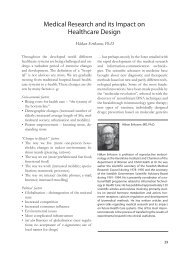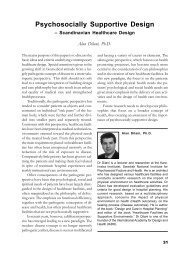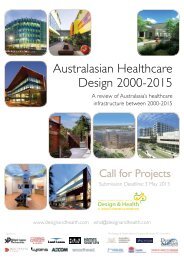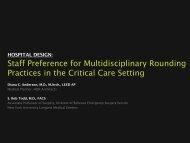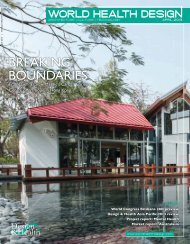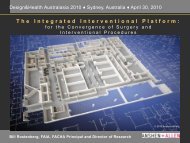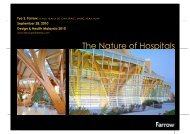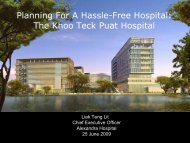SUPER GREEN - the International Academy of Design and Health
SUPER GREEN - the International Academy of Design and Health
SUPER GREEN - the International Academy of Design and Health
- No tags were found...
Create successful ePaper yourself
Turn your PDF publications into a flip-book with our unique Google optimized e-Paper software.
effi ciency, reduce errors <strong>and</strong> injury, build in fl exibility, <strong>and</strong> improve <strong>the</strong>contribution <strong>of</strong> architecture to a healing environment. “Throughout thisprocess, we needed to remind ourselves repeatedly that we are notbuilding with today’s technology in mind or even for <strong>the</strong> innovations <strong>of</strong>10 years from now,” Covert said. 2PPH’s process includes evaluations <strong>of</strong> cutting-edge technologies,including operating suite robotics, remote medical presence via rovingconsultation robots, personal RFID tracking devices, high-tech patientbeds <strong>and</strong> automated systems that monitor patient health status <strong>and</strong>movement, LCD image <strong>and</strong> information panels in each patient room,<strong>and</strong> patient rooms that can be quickly reconfi gured to support rapidlychanging patient needs <strong>and</strong> advances in medical procedures.Shed burdensomeheritage...comefrom nowhere;change <strong>the</strong> game;innovate; <strong>and</strong> actThe innovation challengeA confl ict arises when selecting information <strong>and</strong> high-technology solutions for healthcare environments. Technological innovations<strong>and</strong> developments occur at a pace that is more rapid than <strong>the</strong> architectural process. By <strong>the</strong> time a healthcare facility has beenplanned, approved, <strong>and</strong> built, several new generations <strong>of</strong> technologies may have been tried <strong>and</strong> tested.To meet this challenge, Orl<strong>and</strong>o Portale, PPH’s chief technology <strong>and</strong> innovation <strong>of</strong>fi cer, uses an approach borrowed from systemsdesign philosophy: “Shed burdensome heritage; put everything on <strong>the</strong> table; come from nowhere; fail early <strong>and</strong> small; embraceconstructive dissatisfaction; change <strong>the</strong> game; innovate; <strong>and</strong> act.”This approach considers not only products readily available today, but also looks to future systems at <strong>the</strong> ‘bleeding edge’ <strong>of</strong>technological innovation. This process builds a view <strong>of</strong> <strong>the</strong> future that can be used to formulate more informed <strong>and</strong> educatedguesses about changes in architectural infrastructure. Finally, <strong>the</strong> PPH strategy may include a delay <strong>of</strong> technology purchases until<strong>the</strong> last practical moment, so that innovations can beincorporated when <strong>the</strong> hospital opens in three years.The nature <strong>and</strong> risk <strong>of</strong> healthcare provision posesadditional challenges that arise when choosingtechnologies. The margin <strong>of</strong> error for medical technologiesmust be extremely low. An error rate <strong>of</strong> one may resultin one death or multiple injuries. However, old systemsimpose <strong>the</strong>ir own risks. Portale suggests that <strong>the</strong>y canbe ineffi cient; at worst, deadly, including errors in surgicalorders, medication dosage or follow-up care.Testing technologiesUpdated information technologies <strong>and</strong> operationalsystems are thus being sought to reduce <strong>the</strong> vast amounts<strong>of</strong> information permanently lost because <strong>of</strong> outdated orpoorly conceived information transfer <strong>and</strong> managementsystems. Critical to <strong>the</strong> successful implementation <strong>of</strong>any new system in a complex, high risk environmentsuch as healthcare, is <strong>the</strong> testing <strong>of</strong> technologies byinterdisciplinary planning <strong>and</strong> care teams in clinical unitsduring real-time, real-world healthcare operations or inmock-up conditions.PPH chief nursing executive, Lorie Shoemaker, recruitedstaff from across <strong>the</strong> hospital to participate in a userassessment <strong>of</strong> design concepts <strong>and</strong> to test some <strong>of</strong> <strong>the</strong>technologies on its units. For example, remote telepresenceis being explored in Pomerado’s intensive careunits, using internet <strong>and</strong> video conferencing via <strong>the</strong> InTouch<strong>Health</strong> Kodak camera to review patient results from scans<strong>and</strong> images.A novel mobile robot is being tested as a means toprovide remote medical presence in several clinical areas.The terrace at <strong>the</strong> Palomar Pomerado <strong>Health</strong>’s ‘Hospital <strong>of</strong> <strong>the</strong> Future’WORLD HEALTH DESIGN | October 2008 35



